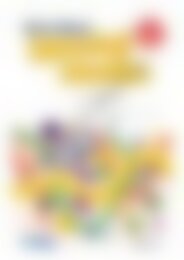20720_Problem_solving_Year_2_Money_and_Financial_Mathematics
You also want an ePaper? Increase the reach of your titles
YUMPU automatically turns print PDFs into web optimized ePapers that Google loves.
Your partner in education<br />
YEAR 2<br />
PROBLEM-SOLVING<br />
IN MATHEMATICS<br />
<strong>Money</strong> <strong>and</strong> financial<br />
mathematics<br />
Two-time winner of the Australian<br />
Primary Publisher of the <strong>Year</strong> Award
<strong>Problem</strong>-<strong>solving</strong> in mathematics<br />
(Book C)<br />
Published by R.I.C. Publications ® 2008<br />
Copyright © George Booker <strong>and</strong> Denise Bond 2007<br />
RIC–<strong>20720</strong><br />
This master may only be reproduced by the<br />
original purchaser for use with their class(es). The<br />
publisher prohibits the loaning or onselling of this<br />
master for the purposes of reproduction.<br />
Copyright Notice<br />
Blackline masters or copy masters are published <strong>and</strong><br />
sold with a limited copyright. This copyright allows<br />
publishers to provide teachers <strong>and</strong> schools with a<br />
wide range of learning activities without copyright<br />
being breached. This limited copyright allows the<br />
purchaser to make sufficient copies for use within<br />
their own education institution. The copyright is not<br />
transferable, nor can it be onsold. Following these<br />
instructions is not essential but will ensure that you,<br />
as the purchaser, have evidence of legal ownership<br />
to the copyright if inspection occurs.<br />
For your added protection in the case of copyright<br />
inspection, please complete the form below. Retain<br />
this form, the complete original document <strong>and</strong> the<br />
invoice or receipt as proof of purchase.<br />
Name of Purchaser:<br />
Date of Purchase:<br />
Supplier:<br />
School Order# (if applicable):<br />
Signature of Purchaser:<br />
Internet websites<br />
In some cases, websites or specific URLs may be recommended. While these are checked <strong>and</strong> rechecked at the time of publication,<br />
the publisher has no control over any subsequent changes which may be made to webpages. It is strongly recommended that the class<br />
teacher checks all URLs before allowing students to access them.<br />
View all pages online<br />
PO Box 332 Greenwood Western Australia 6924<br />
Website: www.ricpublications.com.au<br />
Email: mail@ricgroup.com.au
FOREWORD<br />
Books A–G of <strong>Problem</strong>-<strong>solving</strong> in mathematics have been developed to provide a rich resource for teachers<br />
of students from the early years to the end of middle school <strong>and</strong> into secondary school. The series of problems,<br />
discussions of ways to underst<strong>and</strong> what is being asked <strong>and</strong> means of obtaining solutions have been built up to<br />
improve the problem-<strong>solving</strong> performance <strong>and</strong> persistence of all students. It is a fundamental belief of the authors<br />
that it is critical that students <strong>and</strong> teachers engage with a few complex problems over an extended period rather than<br />
spend a short time on many straightforward ‘problems’ or exercises. In particular, it is essential to allow students<br />
time to review <strong>and</strong> discuss what is required in the problem-<strong>solving</strong> process before moving to another <strong>and</strong> different<br />
problem. This book includes extensive ideas for extending problems <strong>and</strong> solution strategies to assist teachers in<br />
implementing this vital aspect of mathematics in their classrooms. Also, the problems have been constructed <strong>and</strong><br />
selected over many years’ experience with students at all levels of mathematical talent <strong>and</strong> persistence, as well as<br />
in discussions with teachers in classrooms <strong>and</strong> professional learning <strong>and</strong> university settings.<br />
<strong>Problem</strong>-<strong>solving</strong> does not come easily to most people,<br />
so learners need many experiences engaging with<br />
problems if they are to develop this crucial ability. As<br />
they grapple with problem meaning <strong>and</strong> find solutions,<br />
students will learn a great deal about mathematics<br />
<strong>and</strong> mathematical reasoning—for instance, how to<br />
organise information to uncover meanings <strong>and</strong> allow<br />
connections among the various facets of a problem<br />
to become more apparent, leading to a focus on<br />
organising what needs to be done rather than simply<br />
looking to apply one or more strategies. In turn, this<br />
extended thinking will help students make informed<br />
choices about events that affect their lives <strong>and</strong> to<br />
interpret <strong>and</strong> respond to the decisions made by others<br />
at school, in everyday life <strong>and</strong> in further study.<br />
Student <strong>and</strong> teacher pages<br />
The student pages present problems chosen with a<br />
particular problem-<strong>solving</strong> focus <strong>and</strong> draw on a range<br />
of mathematical underst<strong>and</strong>ings <strong>and</strong> processes.<br />
For each set of related problems, teacher notes <strong>and</strong><br />
discussion are provided, as well as indications of<br />
how particular problems can be examined <strong>and</strong> solved.<br />
Answers to the more straightforward problems <strong>and</strong><br />
detailed solutions to the more complex problems<br />
ensure appropriate explanations, <strong>and</strong> suggest<br />
ways in which problems can be extended. Related<br />
problems occur on one or more pages that extend the<br />
problem’s ideas, the solution processes <strong>and</strong> students’<br />
underst<strong>and</strong>ing of the range of ways to come to terms<br />
with what the problems are asking.<br />
At the top of each teacher page, a statement highlights<br />
the particular thinking that the problems will dem<strong>and</strong>,<br />
together with an indication of the mathematics that<br />
might be needed <strong>and</strong> a list of materials that can be<br />
used in seeking a solution. A particular focus for the<br />
page or set of three pages of problems then exp<strong>and</strong>s<br />
on these aspects. Each book is organised so that when<br />
a problem requires complicated strategic thinking, two<br />
or three problems occur on one page (supported by a<br />
teacher page with detailed discussion) to encourage<br />
students to find a solution together with a range of<br />
means that can be followed. More often, problems<br />
are grouped as a series of three interrelated pages<br />
where the level of complexity gradually increases,<br />
while the associated teacher page examines one or<br />
two of the problems in depth <strong>and</strong> highlights how the<br />
other problems might be solved in a similar manner.<br />
R.I.C. Publications ® www.ricpublications.com.au <strong>Problem</strong>-<strong>solving</strong> in mathematics<br />
iii
FOREWORD<br />
Each teacher page concludes with two further aspects<br />
critical to the successful teaching of problem-<strong>solving</strong>.<br />
A section on likely difficulties points to reasoning <strong>and</strong><br />
content inadequacies that experience has shown may<br />
well impede students’ success. In this way, teachers<br />
can be on the lookout for difficulties <strong>and</strong> be prepared<br />
to guide students past these potential pitfalls. The<br />
final section suggests extensions to the problems to<br />
enable teachers to provide several related experiences<br />
with problems of these kinds in order to build a rich<br />
array of experiences with particular solution methods;<br />
for example, the numbers, shapes or measurements<br />
in the original problems might change but leave the<br />
means to a solution essentially the same, or the<br />
context may change while the numbers, shapes or<br />
measurements remain the same. Then numbers,<br />
shapes or measurements <strong>and</strong> the context could be<br />
changed to see how the students h<strong>and</strong>le situations<br />
that appear different but are essentially the same as<br />
those already met <strong>and</strong> solved.<br />
Other suggestions ask students to make <strong>and</strong> pose their<br />
own problems, investigate <strong>and</strong> present background<br />
to the problems or topics to the class, or consider<br />
solutions at a more general level (possibly involving<br />
verbal descriptions <strong>and</strong> eventually pictorial or symbolic<br />
arguments). In this way, not only are students’ ways<br />
of thinking extended but the problems written on one<br />
page are used to produce several more problems that<br />
utilise the same approach.<br />
<strong>Mathematics</strong> <strong>and</strong> language<br />
The difficulty of the mathematics gradually increases<br />
over the series, largely in line with what is taught at<br />
the various year levels, although problem-<strong>solving</strong> both<br />
challenges at the point of the mathematics that is being<br />
learned <strong>and</strong> provides insights <strong>and</strong> motivation for what<br />
might be learned next. For example, the computation<br />
required gradually builds from additive thinking, using<br />
addition <strong>and</strong> subtraction separately <strong>and</strong> together,<br />
to multiplicative thinking, where multiplication <strong>and</strong><br />
division are connected conceptions. More complex<br />
interactions of these operations build up over the<br />
series as the operations are used to both come to terms<br />
with problems’ meanings <strong>and</strong> to achieve solutions.<br />
Similarly, two-dimensional geometry is used at first<br />
but extended to more complex uses over the range<br />
of problems, then joined by interaction with threedimensional<br />
ideas. Measurement, including chance<br />
<strong>and</strong> data, also extends over the series from length to<br />
perimeter, <strong>and</strong> from area to surface area <strong>and</strong> volume,<br />
drawing on the relationships among these concepts to<br />
organise solutions as well as give an underst<strong>and</strong>ing<br />
of the metric system. Time concepts range from<br />
interpreting timetables using 12-hour <strong>and</strong> 24-hour<br />
clocks, while investigations related to mass rely on<br />
both the concept itself <strong>and</strong> practical measurements.<br />
The language in which the problems are expressed is<br />
relatively straightforward, although this too increases<br />
in complexity <strong>and</strong> length of expression across the books<br />
in terms of both the context in which the problems<br />
are set <strong>and</strong> the mathematical content that is required.<br />
It will always be a challenge for some students<br />
to ‘unpack’ the meaning from a worded problem,<br />
particularly as the problems’ context, information <strong>and</strong><br />
meanings exp<strong>and</strong>. This ability is fundamental to the<br />
nature of mathematical problem-<strong>solving</strong> <strong>and</strong> needs to<br />
be built up with time <strong>and</strong> experiences rather than be<br />
iv<br />
<strong>Problem</strong>-<strong>solving</strong> in mathematics www.ricpublications.com.au R.I.C. Publications ®
FOREWORD<br />
diminished or left out of the problems’ situations. One<br />
reason for the suggestion that students work in groups<br />
is to allow them to share <strong>and</strong> assist each other with<br />
the tasks of discerning meanings <strong>and</strong> ways to tackle<br />
the ideas in complex problems through discussion,<br />
rather than simply leaping into the first ideas that<br />
come to mind (leaving the full extent of the problem<br />
unrealised).<br />
An approach to <strong>solving</strong> problems<br />
Try<br />
an approach<br />
Explore<br />
means to a solution<br />
Analyse<br />
the problem<br />
The careful, gradual development of an ability to<br />
analyse problems for meaning, organising information<br />
to make it meaningful <strong>and</strong> to make the connections<br />
among the problems more meaningful in order to<br />
suggest a way forward to a solution is fundamental<br />
to the approach taken with this series, from the first<br />
book to the last. At first, materials are used explicitly<br />
to aid these meanings <strong>and</strong> connections; however, in<br />
time they give way to diagrams, tables <strong>and</strong> symbols<br />
as underst<strong>and</strong>ing <strong>and</strong> experience of <strong>solving</strong> complex,<br />
engaging problems increases. As the problem forms<br />
exp<strong>and</strong>, the range of methods to solve problems<br />
is carefully extended, not only to allow students to<br />
successfully solve the many types of problems, but also<br />
to give them a repertoire of solution processes that<br />
they can consider <strong>and</strong> draw on when new situations<br />
are encountered. In turn, this allows them to explore<br />
one or another of these approaches to see whether<br />
each might furnish a likely result. In this way, when<br />
they try a particular method to solve a new problem,<br />
experience <strong>and</strong> analysis of the particular situation<br />
assists them in developing a full solution.<br />
Not only is this model for the problem-<strong>solving</strong> process<br />
helpful in <strong>solving</strong> problems, it also provides a basis for<br />
students to discuss their progress <strong>and</strong> solutions <strong>and</strong><br />
determine whether or not they have fully answered<br />
a question. At the same time, it guides teachers’<br />
questions of students <strong>and</strong> provides a means of seeing<br />
underlying mathematical difficulties <strong>and</strong> ways in<br />
which problems can be adapted to suit particular<br />
needs <strong>and</strong> extensions. Above all, it provides a common<br />
framework for discussions between a teacher <strong>and</strong><br />
group or whole class to focus on the problem-<strong>solving</strong><br />
process rather than simply on the solution of particular<br />
problems. Indeed, as Alan Schoenfeld, in Steen L. (Ed)<br />
<strong>Mathematics</strong> <strong>and</strong> democracy (2001), states so well, in<br />
problem-<strong>solving</strong>:<br />
getting the answer is only the beginning rather than<br />
the end … an ability to communicate thinking is<br />
equally important.<br />
We wish all teachers <strong>and</strong> students who use these<br />
books success in fostering engagement with problem<strong>solving</strong><br />
<strong>and</strong> building a greater capacity to come to<br />
terms with <strong>and</strong> solve mathematical problems at all<br />
levels.<br />
George Booker <strong>and</strong> Denise Bond<br />
R.I.C. Publications ® www.ricpublications.com.au <strong>Problem</strong>-<strong>solving</strong> in mathematics<br />
v
CONTENTS<br />
Foreword .................................................................. iii – v<br />
Contents .......................................................................... vi<br />
Introduction ........................................................... vii – xix<br />
Teacher notes .................................................................. 2<br />
Larger shapes .................................................................. 3<br />
Grid fun 1 ........................................................................ 4<br />
Grid fun 2 ........................................................................ 5<br />
Teacher notes .................................................................. 6<br />
The big race .................................................................... 7<br />
Teacher notes .................................................................. 8<br />
What’s my number? ........................................................ 9<br />
Missing numbers .......................................................... 10<br />
What’s my age? ............................................................. 11<br />
Teacher notes ................................................................ 12<br />
At the beach .................................................................. 13<br />
At the party ................................................................... 14<br />
In the garden ................................................................. 15<br />
Teacher notes ................................................................ 16<br />
How many digits? ......................................................... 17<br />
Teacher notes ................................................................ 18<br />
Tangrams 1 .................................................................... 19<br />
Tangrams 2 .................................................................... 20<br />
Tangrams 3 .................................................................... 21<br />
Teacher notes ................................................................ 22<br />
Magic squares 1 ........................................................... 23<br />
Magic squares 2 ........................................................... 24<br />
Magic circles ................................................................. 25<br />
Teacher notes ................................................................ 26<br />
Tuckshop ........................................................................ 27<br />
Teacher notes ................................................................ 28<br />
Drive time ...................................................................... 30<br />
Window panes 2 ........................................................... 31<br />
Teacher notes ................................................................ 32<br />
Kangaroo mobs ............................................................. 33<br />
Cooking time ................................................................. 34<br />
Duck pond ..................................................................... 35<br />
Teacher notes ................................................................ 36<br />
Animal trees .................................................................. 37<br />
Teacher notes ................................................................ 38<br />
Animal trails .................................................................. 39<br />
Balance the books ......................................................... 40<br />
Taking time .................................................................... 41<br />
Teacher notes ................................................................ 42<br />
Party food ....................................................................... 43<br />
How long? ..................................................................... 44<br />
At the shops.................................................................... 45<br />
Teacher notes ................................................................ 46<br />
Toothpicks ..................................................................... 47<br />
Building with cubes ...................................................... 48<br />
Stacking cubes .............................................................. 49<br />
Teacher notes ................................................................ 50<br />
How many? ................................................................... 51<br />
Solutions ..................................................................52–55<br />
Tangram resource page ................................................. 56<br />
10 mm x 10 mm grid resource page ............................. 57<br />
15 mm x 15 mm grid resource page ............................. 58<br />
Triangular grid resource page ....................................... 59<br />
Triangular isometric resource page .............................. 60<br />
Square isometric resource page ................................... 61<br />
4-digit number exp<strong>and</strong>er resource page (x 3) ............... 62<br />
Window panes 1 ........................................................... 29<br />
vi<br />
<strong>Problem</strong>-<strong>solving</strong> in mathematics www.ricpublications.com.au R.I.C. Publications ®
TEACHER NOTES<br />
<strong>Problem</strong>-<strong>solving</strong><br />
To solve problems involving money <strong>and</strong> make decisions<br />
based on particular criteria.<br />
Materials<br />
Some students may need counters, play money or a<br />
calculator.<br />
Focus<br />
This page explores the students’ abilities to read for<br />
information, obtain information from another source (the<br />
tuckshop menu) <strong>and</strong> use it to find solutions. The problems<br />
are about using money, making decisions based on money<br />
<strong>and</strong> comparing amounts of money, rather than adding or<br />
subtracting. Solutions can be obtained by using materials<br />
<strong>and</strong> comparing amounts. Counters, blocks, play money or<br />
a calculator may be used if needed.<br />
Possible difficulties<br />
• Unfamiliarity with the ‘$’ symbol<br />
• Not taking into account that they may need two or<br />
more of the same item<br />
• Believing that the exact amount of $6 or $10 has to be<br />
spent as opposed to not spending all of the amount<br />
Extension<br />
• Record <strong>and</strong> discuss the different choices students<br />
make to spend their $10.<br />
• In pairs, students write their own questions based on<br />
the tuckshop menu <strong>and</strong> give them to other pairs to<br />
solve.<br />
Discussion<br />
Page 27<br />
Students read the items on the menu <strong>and</strong> note how much<br />
each costs. The investigation involves students reading the<br />
questions for information as well as getting information<br />
from another source—the tuckshop menu.<br />
Students need to remember what they are buying <strong>and</strong> then<br />
work out how much it costs <strong>and</strong>, in some cases, to add,<br />
subtract or compare amounts to see if they have enough<br />
money. The last two questions have a number of possible<br />
solutions. Some students might choose three items they<br />
would like <strong>and</strong> then add <strong>and</strong> compare only to discover<br />
they don’t have enough money, while others might just<br />
choose the three cheapest items. Either way, they need to<br />
compare money amounts <strong>and</strong> make decisions accordingly.<br />
26<br />
<strong>Problem</strong>-<strong>solving</strong> in mathematics www.ricpublications.com.au R.I.C. Publications ®
TUCKSHOP<br />
S<strong>and</strong>wiches<br />
Juice<br />
Rolls<br />
Milk<br />
1. Kelly has $5. Does she have enough to buy a ham s<strong>and</strong>wich <strong>and</strong> a<br />
chocolate milk?<br />
2. Kurt has $9. Can he buy two chicken rolls <strong>and</strong> a lemon twist drink?<br />
3. Kristy has $10. She buys a ham roll, a cheese s<strong>and</strong>wich <strong>and</strong> a plain<br />
milk. How much money does she have left?<br />
4. Kerry bought three chocolate milks for her<br />
sisters. How much change does she have<br />
from $10?<br />
5. Kwan has $6. He needs to buy lunch for himself<br />
<strong>and</strong> his two brothers. Choose what he can buy<br />
with his money.<br />
6. If you had $10, what would you buy?<br />
R.I.C. Publications ® www.ricpublications.com.au <strong>Problem</strong>-<strong>solving</strong> in mathematics<br />
27
SOLUTIONS<br />
Note: Many solutions are written statements rather than simply numbers. This is to encourage teachers <strong>and</strong> students to<br />
solve problems in this way.<br />
TUCKSHOP ................................................................. page 27<br />
1. Yes. They cost $5<br />
2. No. They cost $10<br />
3. $4<br />
4. $4<br />
5. Answers will vary – e.g. 3 egg s<strong>and</strong>wiches <strong>and</strong> 3 apple<br />
juices<br />
6. Answers will vary – e.g. 1 chicken roll, 1 choc milk<br />
R.I.C. Publications ® www.ricpublications.com.au <strong>Problem</strong>-<strong>solving</strong> in mathematics<br />
53


















